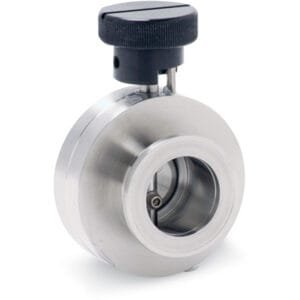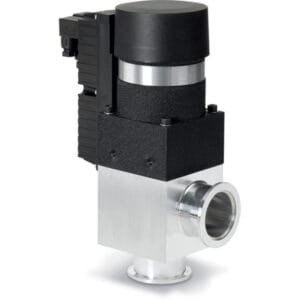Overview of CF (ConFlat) Flange in Vacuum Systems
The CF (ConFlat) flange system is one of the most commonly utilized flange types in both high vacuum and ultra-high vacuum (UHV) applications. It provides a reliable, leak-tight seal, which makes it ideal for critical applications requiring stringent vacuum conditions. Many vacuum components, including gauges, instruments, feedthroughs, and accessories, are compatible with this flange system.
Blank (Blind) Flanges: Purpose and Usage
A blank (or blind) flange is a solid, disc-shaped fitting used primarily to close off unused ports or sections in vacuum systems. In addition to sealing off these sections, blank flanges can be machined for custom fittings, offering flexibility in vacuum chamber designs.
Sealing Mechanism of CF Flanges
The CF flange system employs a unique knife-edge sealing mechanism to create a vacuum-tight seal. This knife-edge, located slightly below the flat surface of the flange, interacts with a soft metal gasket. As the flange bolts are tightened, the knife-edge indents the gasket, forming concentric grooves. This process causes the metal to fill surface imperfections on the flange, ensuring a highly effective seal. The CF seal can maintain vacuum levels from atmospheric pressure (760 torr or 103 mbar) down to < 1 x 10^-13 torr (< 1.3 x 10^-13 mbar), operating within a temperature range of -196°C to 450°C, depending on the materials used.
Flange Size Nomenclature
The way CF flange sizes are referenced can vary by region. In North America, flange sizes are typically denoted by their outer diameter (O.D.). However, in Europe and parts of Asia, the nominal internal diameter (nominal I.D.), referring to the largest tube that can be welded to the bored flange, is often used.
Types of ConFlat Flanges
There are four main variations of ConFlat flanges available, providing flexibility for different applications:
Fixed Flange
The fixed flange design is a single-piece construction where the orientation of the bolt holes is set relative to the fitting. This type of flange is commonly used when a specific alignment is required.
Rotatable Flange
The rotatable flange consists of two components: an inner weld ring and an outer bolt ring. The bolt ring is able to rotate around the weld ring, making it easier to align bolt holes during installation, especially in complex assemblies.
Both fixed and rotatable flanges can be supplied with either through holes (clearance holes) or tapped holes, giving users more options depending on their setup requirements.
Applications of CF Flanges in Vacuum Systems
Due to their robust sealing properties and flexibility, CF flanges are widely used in UHV systems across various industries, including semiconductor manufacturing, materials science research, and high-energy physics. The versatility of these flanges ensures their compatibility with a wide range of vacuum components, making them essential in precision vacuum environments.
Ordering Table
|
Flange Size/OD |
Type |
Flange Material |
Drawing |
Part Number |
Nominal Tube OD |
Bore |
Counter Bore |
Thickness |
Bolt Circle Dia. |
Bolt Hole Dia. |
# of Bolt Holes |
Thread Size |
Note |
|
DN16CF (1.33" OD) |
Fixed |
304L SS |
 
|
F0133X000N |
— |
Blank |
— |
0.30 |
1.062 |
0.172 |
6 |
— |
— |
|
DN16CF (1.33" OD) |
Fixed Tapped |
304L SS |
 
|
F0133X000NM |
— |
Blank |
— |
0.30 |
1.062 |
— |
6 |
M4 x 0.7P |
— |
|
DN16CF (1.33" OD) |
Fixed Tapped |
304L SS |
 
|
F0133X000NT |
— |
Blank |
— |
0.30 |
1.062 |
— |
6 |
#8-32 |
— |
|
DN16CF (1.33" OD) |
Fixed Weldneck |
304L SS |
 
|
F0133X000NW |
— |
Blank |
— |
0.30 |
1.062 |
0.172 |
6 |
— |
— |
|
DN16CF (1.33" OD) |
Rotatable |
304L SS |
 
|
F0133X000R |
— |
Blank |
— |
0.30 |
1.062 |
0.172 |
6 |
— |
— |
|
DN16CF (1.33" OD) |
Rotatable Tapped |
304L SS |
 
|
F0133X000RM |
— |
Blank |
— |
0.30 |
1.062 |
— |
6 |
M4 x 0.7P |
— |
|
DN16CF (1.33" OD) |
Rotatable Tapped |
304L SS |
 
|
F0133X000RT |
— |
Blank |
— |
0.30 |
1.062 |
— |
6 |
#8-32 |
— |
|
DN16CF (1.33" OD) |
Rotatable Tapped Weldneck |
304L SS |
 
|
F0133X000RTW |
— |
Blank |
— |
0.30 |
1.062 |
— |
6 |
#8-32 |
— |
|
DN16CF (1.33" OD) |
Rotatable Weldneck |
304L SS |
 
|
F0133X000RW |
— |
Blank |
— |
0.30 |
1.062 |
0.172 |
6 |
— |
— |
|
DN16CF (1.33" OD) |
Fixed |
304L SS |
 
|
F0133X025N |
1/4 |
0.255 |
— |
0.30 |
1.062 |
0.172 |
6 |
— |
— |
|
DN16CF (1.33" OD) |
Fixed Tapped |
304L SS |
 
|
F0133X025NT |
1/4 |
0.255 |
— |
0.30 |
1.062 |
— |
6 |
#8-32 |
— |
|
DN16CF (1.33" OD) |
Rotatable |
304L SS |
 
|
F0133X025R |
1/4 |
0.255 |
— |
0.30 |
1.062 |
0.172 |
6 |
— |
— |
|
DN16CF (1.33" OD) |
Rotatable Tapped |
304L SS |
 
|
F0133X025RT |
1/4 |
0.255 |
— |
0.30 |
1.062 |
— |
6 |
#8-32 |
— |
|
DN16CF (1.33" OD) |
Fixed |
304L SS |
 
|
F0133X037N |
3/8 |
0.380 |
— |
0.30 |
1.062 |
0.172 |
6 |
— |
— |
|
DN16CF (1.33" OD) |
Fixed Tapped |
304L SS |
 
|
F0133X037NT |
3/8 |
0.380 |
— |
0.30 |
1.062 |
— |
6 |
#8-32 |
— |
|
DN16CF (1.33" OD) |
Rotatable |
304L SS |
 
|
F0133X037R |
3/8 |
0.380 |
— |
0.30 |
1.062 |
0.172 |
6 |
— |
— |
|
DN16CF (1.33" OD) |
Rotatable Tapped |
304L SS |
 
|
F0133X037RT |
3/8 |
0.380 |
— |
0.30 |
1.062 |
— |
6 |
#8-32 |
— |
|
DN16CF (1.33" OD) |
Fixed |
304L SS |
 
|
F0133X050N |
1/2 |
0.505 |
— |
0.30 |
1.062 |
0.172 |
6 |
— |
— |
|
DN16CF (1.33" OD) |
Fixed Tapped |
304L SS |
 
|
F0133X050NM |
1/2 |
0.505 |
— |
0.30 |
1.062 |
— |
6 |
M4 x 0.7P |
— |
|
DN16CF (1.33" OD) |
Fixed Tapped |
304L SS |
 
|
F0133X050NT |
1/2 |
0.505 |
— |
0.30 |
1.062 |
— |
6 |
#8-32 |
— |
|
DN16CF (1.33" OD) |
Rotatable |
304L SS |
 
|
F0133X050R |
1/2 |
0.505 |
— |
0.30 |
1.062 |
0.172 |
6 |
— |
— |
|
DN16CF (1.33" OD) |
Rotatable Tapped |
304L SS |
 
|
F0133X050RT |
1/2 |
0.505 |
— |
0.30 |
1.062 |
— |
6 |
#8-32 |
— |
|
DN16CF (1.33" OD) |
Fixed |
304L SS |
 
|
F0133X062N |
5/8 |
0.63 |
— |
0.30 |
1.062 |
0.172 |
6 |
— |
— |
|
DN16CF (1.33" OD) |
Fixed |
304L SS |
 
|
F0133X075N |
3/4 |
0.63 |
0.760 |
0.30 |
1.062 |
0.172 |
6 |
— |
1 |
|
DN16CF (1.33" OD) |
Fixed Tapped |
304L SS |
 
|
F0133X075NM |
3/4 |
0.63 |
0.760 |
0.30 |
1.062 |
— |
6 |
M4 x 0.7P |
1 |
|
DN16CF (1.33" OD) |
Fixed Tapped Weldneck |
304L SS |
 
|
F0133X075NMW |
3/4 |
0.63 |
— |
0.30 |
1.062 |
— |
6 |
M4 x 0.7P |
— |
|
DN16CF (1.33" OD) |
Fixed Tapped |
304L SS |
 
|
F0133X075NT |
3/4 |
0.63 |
0.760 |
0.30 |
1.062 |
— |
6 |
#8-32 |
1 |
|
DN16CF (1.33" OD) |
Fixed Tapped Weldneck |
304L SS |
 
|
F0133X075NTW |
3/4 |
0.63 |
— |
0.30 |
1.062 |
— |
6 |
#8-32 |
— |
|
DN16CF (1.33" OD) |
Fixed Weldneck |
304L SS |
 
|
F0133X075NW |
3/4 |
0.63 |
— |
0.30 |
1.062 |
0.172 |
6 |
— |
— |
|
DN16CF (1.33" OD) |
Rotatable |
304L SS |
 
|
F0133X075R |
3/4 |
0.63 |
0.760 |
0.30 |
1.062 |
0.172 |
6 |
— |
1 |
|
DN16CF (1.33" OD) |
Rotatable Tapped |
304L SS |
 
|
F0133X075RM |
3/4 |
0.63 |
0.760 |
0.30 |
1.062 |
— |
6 |
M4 x 0.7P |
1 |
|
DN16CF (1.33" OD) |
Rotatable Tapped Weldneck |
304L SS |
 
|
F0133X075RMW |
3/4 |
0.63 |
— |
0.30 |
1.062 |
— |
6 |
M4 x 0.7P |
— |
|
DN16CF (1.33" OD) |
Rotatable Tapped |
304L SS |
 
|
F0133X075RT |
3/4 |
0.63 |
0.760 |
0.30 |
1.062 |
— |
6 |
#8-32 |
1 |
|
DN16CF (1.33" OD) |
Rotatable Tapped Weldneck |
304L SS |
 
|
F0133X075RTW |
3/4 |
0.63 |
— |
0.30 |
1.062 |
— |
6 |
#8-32 |
— |
|
DN16CF (1.33" OD) |
Rotatable Weldneck |
304L SS |
 
|
F0133X075RW |
3/4 |
0.63 |
— |
0.30 |
1.062 |
0.172 |
6 |
— |
— |





Reviews
There are no reviews yet.